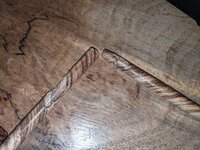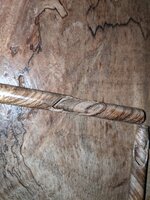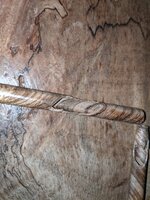harik.raif
Member
Hi, this is my second issue turning a long barrel for a pentel mechanical pencil. As I mentioned before I purchased a nice step drill bit and mandrel. Once I do get a blank drilled, I put it on the mandrel, rough it down ( with a 5/8" bowl gauge, you might think is crazy but works pretty well ), then when I'm getting pretty close to the end it blows out a chunk. I'm not getting a perceptible catch. I'm taking a pretty fine cut, no more than a 32nd. I'm turning at about 3k rpm. and I'm using a sharp skew. This is pretty frustrating. Just like with the drilling I blew out 3 blanks this way. So I lost 4 blanks drilling then lost 3 more turning leaving just one pencil left. I will probably destroy that one too. I'm just trying to figure out how.
Anyway, any thoughts/help would be appreciated.
Anyway, any thoughts/help would be appreciated.



